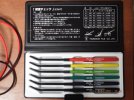Hey all, here is my second post. Hopefully in the right forum. It was this or the general forum as far as I could tell...
Anyway, I took a risk a few months ago and ordered some Damascus knives from a maker in Pakistan via Alibaba. They arrived a bit dirty, and seemed rusty. I just worked on cleaning them today, and in the process I seem to have been able to wear down the etch of the Damascus pattern. With just elbow grease and a green scotch-brite pad.
Here's a couple photos, captioned with which is which: Sorry for the poor lighting.
The blades are supposed to be around 60hrc.
Is a scotch brite pad really strong enough to wear that down? Or did I get gypped?
Thanks in advance!
Anyway, I took a risk a few months ago and ordered some Damascus knives from a maker in Pakistan via Alibaba. They arrived a bit dirty, and seemed rusty. I just worked on cleaning them today, and in the process I seem to have been able to wear down the etch of the Damascus pattern. With just elbow grease and a green scotch-brite pad.
Here's a couple photos, captioned with which is which: Sorry for the poor lighting.
The blades are supposed to be around 60hrc.
Is a scotch brite pad really strong enough to wear that down? Or did I get gypped?
Thanks in advance!




